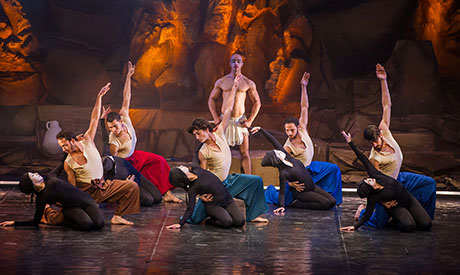Walid Aouni’s theatrical dance piece A Sculptor’s Dream delves into a surreal world that is both familiar and strange.
Directed by Aouni, The Egyptian Modern Dance Theater Company performed A Sculptor’s Dream on 27 and 28 January at the Cairo Opera House Grand Hall, with an upcoming performance in Alexandria on 6 and 7 February.
A Sculptor’s Dream was inspired by the life and work of iconic Egyptian sculptor Mahmoud Mohktar, which spanned the Renaissance in Egypt during the 1920s.
The piece will speak more loudly to those familiar with Mokhtar’s work. His iconic statues of marble and bronze were deeply rooted in Egyptian heritage, drawing from pharaonic motifs, and fusing them with a modernist approach, making him a pioneer for his contemporaries and generations to come.
Through his sculptures, he continuously reflected the revolution surrounding him, with themes of social and political liberation, touching upon female empowerment, as well as the natural landscape and authentic characters.
Appropriately, A Sculptor’s Dream performed this year marks Mahmoud Mokhtar’s 125th birthday, as Aouni pays homage to the sculptor’s world.
If dreams remain an elusive subject in science, art has repeatedly found ways to visualise and capture them.
Though there are main characters, it is fitting that the dance piece forsakes a narrative flow in the traditional sense, to portray dreams as the amorphous experiences they are.
As such, A Sculptor’s Dream is like episodes of impressions, like a series of moving paintings that are both figurative and abstract.
The first character on stage, and the most prominent throughout the performance, is a half-naked man dressed in an ancient Egyptian white tunic. In his hands he holds a chisel and hammer, which he hands to another main character: The Sculptor.
The sculptor is identified by his working clothes, a white artist coat, black jeans, and sturdy black leather shoes. The relationship between the former and the latter is more a guardianship than a mentorship—as if the gods of ancient Egypt were watching over the sculptor without interfering in his work.
The chisel and hammer are struck together in turns by them both throughout the performance, ceremoniously producing a percussive clinking sound that accentuates the music.
The selection of authentic folk music (an anthology credibly researched by Tibero Alexander) rendered the music a powerful presence on the stage.
The most interesting aspect was a classical composition that played in the background, almost without interruption, with other different musical excerpts merging in and out of it. At times the music stops abruptly to change the mood and beat of the dance.
This layering and these shifts imbued the dance with an intense symbolic language, albeit alienating at times.
It snaps one out of the dream, and leaves us comparing the difference in beats, but not quite allowing us to settle with our guesses.
Music in contemporary dance can be used to send cues, be they direct or abstract, as the viewer looks for keys to crack the code, a bridge to this staged world before him. This bridge in A Sculptor’s Dream was intriguing yet enigmatic.
This is perhaps one the piece’s strengths, as it teases us with the familiar elements of Mokhtar’s world, yet places it in a wholly surreal world of a different language, sparking question marks and raising discussions with fellow audience members after the show.

(Photo: Bassam Al Zoghby)
The most exquisite element of the performance was segments of dancers embodying sculptures.
Sometimes functioning as a group, other times one is singled out, with fluid expressive movements, these dancers are sometimes clad in black suits, and other times in white sheets.
The way they manipulate these sheets allows for Mokhtar’s famous sculptures, already bursting with silent life, to come alive on stage.
We see the iconic Khamassin piece, as the sculptor carves her lovingly, with minimal moves that suggest, without overdoing, the art of carving. The Khamassin marble piece is admired for the wind’s movement that Mokhtar managed to capture in stone.
Another artwork cameo is The Jar Bearer, as well as The Beggars and The Blind, and Bride of The Nile, among others.
It is in these segments that the light truly marries with the dance movements effectively.
The light functioned visually and artistically to highlight and dramatise the dances, echoing the way Mokhtar’s sculptures shifted with an awareness of light and shadow.
The piece ends the same way history ends: We are left without the sculptor, but with much to ponder and dream about.

(Photo: Bassam Al Zoghby)
For more arts and culture news and updates, follow Ahram Online Arts and Culture on Twitter at @AhramOnlineArts and on Facebook at Ahram Online: Arts & Culture
Short link: